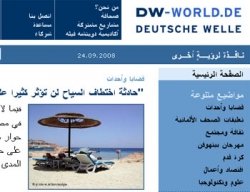Click here to download the charts and tables for this article (PDF)
This article examines Deutsche Welle’s Arabic television programming to evaluate its goal of promoting intercultural dialogue. Framed around the concept of media-promoted intercultural dialogue, the paper presents the results of a comparative content analysis of Deutsche Welle and two pan-Arab satellite channels, al-Jazeera and al-Arabiya. Taking the results as a starting point, I propose suggestions for how to improve the performance of government-sponsored international broadcasting to overcome cultural divides.
Functions of international broadcasting
Starting in the 1930s and increasing with the beginning of the Cold War, several countries began complementing traditional diplomacy by setting up so-called “public diplomacy” programs. Hans N. Tuch, a diplomat in a leading position at the U.S. Information Agency until 1985 and former director of the Voice of America, defined public diplomacy as “a government’s process of communicating with foreign publics in an attempt to bring about understanding for its nation’s ideas and ideals, its institutions and culture, as well as its national goals and current policies.”[i]
To promote these ideas, values and policies, cultural institutions such as the Goethe Institute or the British Council were founded. Furthermore, academic exchange services like the German DAAD or the American Fulbright Commission were established to give foreign elites an understanding of the other nation’s goals and culture. While these instruments focus on small but important target groups, mass media reach the broader public. Subsequently, many Western states founded specific channels to attract foreign publics. France started Radio France International in 1931 and the British launched the BBC World Service in the following year. The U.S. followed with Voice of America in 1942, later adding special regional stations like Radio Free Europe, Radio Free Asia or Radio Martí targeting Cuba. The German Deutsche Welle was established in 1953. In addition to Western channels, socialist countries or regional powers also started to broadcast internationally, such as Egypt with Nasser’s Voice of the Arabs. In the 1980s, international broadcasting entered the television sector, including, for example, French TV5 or the British BBC World.
While international broadcasting became a mainstay of many nations’ public diplomacy efforts, the states running these channels attribute differing functions to them. In a comparative analysis of the international broadcasting of five nations[ii] Groebel identified six possible functions.[iii] Two main functions of most Western channels are 1) the focus on being a gateway for accurate information in crises and 2) compensation for the lack of media supply in underdeveloped regions. On the other hand, France and Germany particularly focus on the function of 3) representing a certain culture and language as well as on 4) offering a connection to the home country for fellow countrymen abroad. Groebel characterizes the U.S. approach as being 5) “missionary” in that it has “the goal of disseminating certain social and political convictions, concepts and ideologies.”[iv] The British BBC, however, is seen as a 6) global player that tries to encompass all but the missionary function in addition to being a global news channel.
Until the 1990s, the intervening, compensatory and missionary approaches might have been legitimated by the presence of authoritarian media systems in Eastern Europe, Asia, and the Arab world. However, due to the enhancement of the media infrastructure and the rapid global expansion of information technology, the issue of inadequate access to information has diminished. The Arab World in particular has become the opposite of a closed-off region. The monitoring organization Arab Advisors Group[v] counted 370 free-to-air satellite TV-channels. 56 of these broadcast privately-produced programming while 38 air state-produced content. In addition, there are several news channels, entertainment channels as well as other special-interest programs.
Given this proliferation of options, it is necessary to ask if government-sponsored international broadcasting in the Arab World has been made outdated by globalization and digitalization. While Marc Lynch predicts that most of these channels “are most likely to simply disappear into the ocean of other broadcasters,”[vi] Kai Hafez disagrees, arguing that government-sponsored international broadcasting has great potential in a world shaped by migration and transnational events because of its original construction as a system-interdependent medium.[vii] According to Hafez, an international channel targeting certain regions “is dependent for its own survival not only on the financial support of the home government, but also on finding acceptance on foreign markets.”[viii]
Thus, this potential will only be realized if the functions of international broadcasting reflect the present situation of regional media systems. Simply providing access to information is not a sufficient main goal; rather, such broadcasting should aim to foster analysis and interpretation of this information against the background of specific cultural and political understandings. This can be termed the “dialogue function.”
The common definition of dialogue refers to the exchange of information and views between two actors or representatives of two groups.[ix] Thus, the implicit aim of a dialogue is to broaden one’s horizon and to understand the other and the rationale behind his actions. For mass media like radio and television, engaging in such a dialogue seems difficult because the flow of information is generally directed one-way. Picking up this point, Oliver Zöllner argues that in a dialogue-oriented model of broadcasting the public should not be seen as a target audience only, but should be made “partners in the meaning-making process.”[x] Zöllner, in referring to Habermas’ theory of communicative action, proposes a communication model of “negotiated understanding.”[xi] Hafez elaborates on this proposition, adding that for a dialogue between two cultures on the media level, “the broadcasting countries’ interest in presenting themselves in a particular way” has to be balanced sensibly “with the target countries’ interest in information.“[xii]
Following from these theoretical assumptions, the international broadcasters in the Arab world must consider the agenda set by relevant regional media to remain attractive to local audiences. Since the rise of new media in the Arab world, al-Jazeera and al-Arabiya have become regional opinion leaders for Arab audiences. Therefore, news programs targeted at the Arab region can only be successful if their agenda and their regional reference is positioned and adjusted to that of the market-leading al-Jazeera and al-Arabiya networks. Thus, DWTV has partly to follow the agenda of both pan-Arab news channels, in particular with their regional reference and topics of mutual interest to both cultures.
On the other hand, international broadcasting aims to introduce topics and views from the home country to broaden a foreign public’s agenda and to stimulate new perspectives. However, to reach this goal, the existing agenda must be complemented by topics that relate to regional interests and cultural concepts.
Deutsche Welle and its competitors
In a 2005 revision of its mission statement, Deutsche Welle explicitly positions the dialogue function as a main aim:
Deutsche Welle was commissioned to convey ‘German and other positions on important issues, chiefly from politics, the arts and economics" to people abroad "as well as to provide a forum in Europe and other continents aimed at promoting understanding and dialog between cultures and peoples.’ Promoting the German language is another part of the DW mission.[xiii]
To fulfill this mission, Deutsche Welle broadcasts radio programming and produces online content in 30 languages as well as a 24-hour TV-program in German and English supplemented with regional programming windows in Arabic and Spanish. Measuring audience size is difficult. Optimistic self-evaluations assume 65 million listeners, 28 million viewers per week[xiv] and 5 million online users per month.[xv] DWTV seems to be particularly popular in Latin America, reaching 3.5 percent of the respective national audiences.[xvi]
Deutsche Welle is a public station within the German ARD national television network. However, it is subsidized by the Ministry of Culture, rather than financed by obligatory license fees. Until 2010, Deutsche Welle operates on an annual budget of €271 m, which at the same time means an annual decrease of almost five percent since 1998.[xvii] This contrasts with the policies of the United Kingdom and the U.S., which have increased their international broadcasting budgets considerably in the last two years.[xviii] In light of this disparity, Manfred Kops from the Institute of Broadcasting Economics at the University of Cologne concludes that “the increase of the importance of international and intercultural communication is not reflected in the budget Germany provides for its international broadcasting.”[xix] While not on par with the British or American broadcasting budgets, Deutsche Welle has boosted broadcasting efforts to the Arab world following September 11 and the invasion of Iraq.
With Radio Sawa and al-Hurra TV the U.S. launched two Arabic broadcasters in 2002 and 2004 that are funded with €54 m annually.[xx] In 2005, Russia started an Arabic 24/7-news-channel Russia Today followed in 2006 by France with an Arabic version of France 24. The BBC followed in 2008 with its long-awaited Arabic TV network that supposedly works on an annual budget of about €30 m.[xxi]
Deutsche Welle launched its Arabic TV programming in 2003 with a daily three-hour broadcast and extended it to nine hours in spring 2007. This was made possible after an increase in funding up to €8 m. These nine hours of programming are spread throughout the entire day alternating with English and German segments. Dispersal of the Arabic content in this way tends to limit DWTV’s audience in the Arab world.
Most of DWTV’s Arabic programming consists of magazines, news reporting and documentaries that have been produced for German audiences and are broadcasted with Arabic subtitles. Once again, the chance to reach the wider Arab public was lost. The only programs specifically produced for an Arab speaking audience were at the time of research five half-hour newscasts and a bi-weekly talk show in cooperation with Abu Dhabi TV. The Arab-language newscasts were chosen for comparative content analysis since they constitute the part of DWTV’s program that targets Arab audiences in particular.
Analysis of DWTV Arabia
Quantitative content analysis is a useful tool for measuring how well DWTV Arabia reflects and complements the programming of al-Jazeera and al-Arabiya, two pan-Arab channels that have become leaders in the Middle East news market. Four broadcast days, two in 2006 and two in 2007 were chosen to analyze all news items of three daily newscasts each on DWTV Arabia, al-Jazeera and al-Arabiya. Each news item was coded in four categories according to topic, regional reference, journalistic style of presentation and thematic field.
In order to prevent possible day-related distortions, the content analyses included different days of the week. Moreover, to take possible developments in the program design into account, the analyses were carried out in two different years, before and after DWTV’s programming had been extended from three to nine hours. The first collection of data took place on a Saturday and Sunday in May 2006, and the second collection on a Tuesday and Wednesday in September 2007. However, significant changes of the newscasts with respect to the topics chosen, regional reference, style of presentation and thematic field along with the extension from 2006 to 2007 cannot be observed from the data. Despite the increase in broadcast hours between 2006 and 2007, the news content and style of presentation did not change appreciably.
Results and discussion
Through comparative content analysis, 634 news items and a total of 204 different topics were identified (see table 1).
To ascertain thematic intersections among the different media, all news items were tagged by topic, and the number of times that topic appeared in the various outlets was counted. The number of items containing the same topic was also measured. Thus, we could not only count the sheer number of thematic intersections, but also gauge the relative importance attributed to each topic. The amount of topical overlap between the three stations was then calculated.[xxii] Figure 1 illustrates the thematic intersections of the three channels weighted by the number of news items the topics appeared in.
All three networks covered the same topics in a total of 39.6% of all news items. Thus, the general thematic convergence of the three channels is relatively high. Al-Jazeera and al-Arabiya overlapped 17.4% of all news items, while airing exclusive stories between 9.0 and 16.8% of the time.
Negative agenda
At first glance, these figures indicate that DWTV closely follows the agenda of the Arab channels. A closer look, however, reveals that the shared agenda of the three channels comprises mostly of wars, conflicts and disasters around the world. These topics are found in German, French or British newscasts because they are dramatic and newsworthy, such as an earthquake in Indonesia[xxiii] or the explosion of an oil pipeline in Nigeria.[xxiv] Admittedly, part of the shared conflict agenda refers to the Middle East, encompassing the Israeli-Palestinian conflict, Iraq war or the Iran nuclear issue.
In fact, the findings are rather disenchanting; the three TV-channels devote one third of their reporting to the same events, but almost all of these shared topics are part of a global conflict agenda. Thus, DWTV runs the risk of being just another showcase for disaster reports with a German point of view, rather than an invitation to the Arab public to participate in intercultural dialogue.
Few references to the region
A comparison of the regional reference of the news items reveals a significant divergence between DWTV and the Arab channels. While al-Jazeera and al-Arabiya devote about half of their news reports to the Arab World and Israel, DWTV refers to the Arab region in less than a fifth of its news items. Instead, its reference to Germany and Europe totals more than 50 percent. (see figure 2)
With only 20 percent of its news coverage devoted to the Arab World, DWTV Arabia covers its target audience’s home region significantly less than its competitors. On the other hand, broadening the agenda to cover topics beyond the Arab region is also a key international broadcasting goal. However, the channel needs to choose topics that guarantee at least some connectivity to the Middle East. It is questionable whether this connection is achieved by focusing on European topics of little relevance to Arab viewers, such as meetings of German political parties,[xxv] discussions on the German federal budget[xxvi] or a cobra which guards a woman’s shoe in London’s Harrod’s departments store.[xxvii]
Lack of thematic connectivity
In addition to its eurocentric focus, many issues were omitted from DWTV’s agenda that might have stimulated intercultural dialogue had they been broadcast. During the study period, such topics included a demonstration of independent judges in Egypt[xxviii] or a sit-in of Tunisian lawyers demanding freedom of speech.[xxix] Moreover, a huge demonstration of migrants in France against the new immigration law was covered by al-Jazeera but not by DWTV.[xxx]
These topics were not prominently placed by the pan-Arab channels, but they were certainly among the top issues in the affected Arab countries. DWTV might have omitted these issues to avoid diplomatic tensions with Arab governments, as DWTV is generally seen as a mouthpiece of the German government. Nevertheless, DWTV should dare to broadcast these kind of issues connected to Arab publics by putting them in a larger context such as questions on freedom of opinion or migration, and, thus, promoting intercultural understanding.
On the other hand, DWTV set some exclusive topics focusing on Europe that were characterized by a high relevance for Arab audiences such as the discussions about the German army’s mandate in Afghanistan or Lebanon.[xxxi] These topics are useful for communicating German views and positions to targeted elites as well as the larger Arab public.
Inadequate presentation
These positive aspects, however, are often hurt by inadequate presentation. Lacking correspondents, DWTV relies mostly on material from news agencies and thus presents such topics with short voice-overs or impersonal reports only. In contrast to the two Arab channels, however, these reports are rarely supplemented by interviews or commentary.
The strength of the pan-Arab news-channels – particularly of al-Jazeera – lies in an ability to deal with topics comprehensively by applying different presentation forms. This better contextualizes topics, and increases the possibility of their being remembered and understood by an audience.[xxxii] Dynamic, engaging presentation is a necessity for any station hoping to affect the public agenda and influence views and opinions. For example, the Petraeus-Crocker report on the situation in Iraq in September 2007 dominated the newscasts of the Arab channels, which presented information in interviews, statements or reports. DWTV, on the other hand, covered this topic in a single voice-over report in each of its newscasts. (see table 2)
In contrast to this finding, a different example from 2007 illustrates how topics can be made memorable and interesting to Arab audiences through adequate presentation: DWTV explained the foreign policy strategy of the European Union in several successive news items. One of these news items referred to EU-internal differences on the strategy; another item personalized the topic by focusing on certain European actors and their interests; and a third item provided a direct link of the EU’s foreign policy to its impact on the Arab World. Instead of working off a wide variety of topics with superficial voiceover reports, this kind of "explanatory piece" with a regional reference have much more potential to provide Arab audiences with different views and opinions, thus fostering interest in dialogue. To better perform its dialogue function, DWTV should produce longer reports with a stronger connectivity to the Arab region and a wider variety of presentation styles.
De-politicized themes
The examined newscasts were dominated by political topics, yet DWTV is not obliged to stick to this scheme. On the contrary, themes like arts and culture, society or science and technology offer opportunities for mutual learning and may serve to reinforce intercultural dialogue in contrast to the highly political al-Jazeera and al-Arabiya.
Table 3 shows that non-political themes such as economics, arts and culture, society and science and technology are more often featured by DWTV than by both Arab channels. Moreover, most of the magazines on DWTV Arabia follow this de-politicizing strategy. However, this appealing extension of DWTV’s agenda is counteracted by a lack of relevance to the Arab region. During the period of analysis, the subtitled magazines did not include a single reference to the Arab World. (see table 3)
Interlinking newscasts with DWTV’s magazines suggests several ways to promote intercultural dialogue. Promoting a “business location Germany” storyline that highlights investment opportunities in Germany could appeal to the Arab business elite. At the same time, the role of trade unions in shaping the economy can be embedded in DWTV’s economic coverage. Presenting civil commitment and its implications for economic reform could help stimulate Arab civil societies. Strikes in Germany, for example, are an issue that might be connected to similar events in the Arab World, thus promoting dialogue.
The same applies to the field of arts and culture. While cultural subjects are underrepresented in its newscasts, DWTV devotes several magazines to cultural issues, exceeding al-Jazeera’s and al-Arabiya’s culture coverage by far. In the Arab World, there are a lot of interesting events in the fields of arts and culture such as book fairs and festivals. Many critical intellectuals and artists involved with these activities are underrepresented in Arab media but worth featuring. DWTV could be a means to introduce their positions, views and projects to Arab audiences. Furthermore, social issues such as the compatibility of having a family and a job can be discussed using European examples while at the same time implicitly or explicitly referring to problems in the Arab World. Thus, the lack of correspondents could be compensated by choosing German and European topics with a regional connection.
Reacting to recent criticisms of DWTV Arabia’s performance, the channel started co-producing two new talk shows with Egypt-TV and the Algerian EPTV in 2008. With these monthly programs on youth issues or Mediterranean issues respectively DWTV-director Christoph Lanz claims to “engage in real dialogue between the cultures instead of simply broadcasting programs to Arab countries”.[xxxiii]
Conclusion
German international broadcasting has subscribed to the mission of promoting intercultural dialogue. In the light of the development of media infrastructure in the Arab World, this seems to be the appropriate strategy for going forward with government-sponsored international broadcasting. However, by analyzing Deutsche Welle’s conception of dialogue, Zöllner has argued that this seems more like a “unilateral, self-serving and functionalist strategy that seeks to accumulate some form of ‘social capital.’”[xxxiv]
This content analysis of Deutsche Welle’s Arab newscasts confirmed this conclusion in that it neither sufficiently adapted to the dominant Arab news agenda, nor extended it meaningfully by using connective topics. Deficits in particular are the lack of Middle East regional reference, the inadequate presentation of topics and the primarily conflict-driven news agenda.
Deutsche Welle’s programming has potential to foster intercultural dialogue, for example, by focusing on non-political news and feature magazines in the fields of arts and culture, society or economics. Topics within these fields might better generate dialogue between cultures than controversial political issues. Nonetheless, this potential needs to be supported by an adequate financial budget and institutional backing from the German government.
Carola Richter is a teaching and research assistant at the Department for Media and Communication at the University of Erfurt, Germany. Her focus is on media systems in the Arab world. She is currently working on her PhD thesis on Islamist media in Egypt.
 Arab Media & Society The Arab Media Hub
Arab Media & Society The Arab Media Hub





